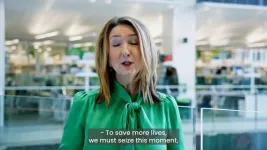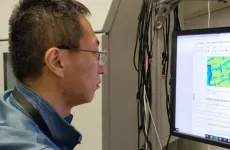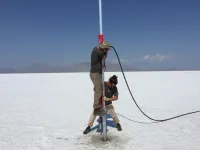(Press-News.org) UNDER EMBARGO UNTIL 6:30 PM EST, Feb. 21, 2024
A UCLA Health-led study found a combination of interventions of one-on-one telehealth coaching, peer support forums, and automated text messages more than doubled the use of the HIV prevention strategy, called PrEP, among younger, at-risk Americans, a group that historically has had low use of the medication.
The randomized controlled trial results, published in the journal Lancet Digital Health, tested combinations of interventions to improve HIV prevention behaviors, including pre-exposure prophylaxis, or PrEP, among younger Americans who have historically had the lowest rate of uptake of the drug among the 1.2 million people in the U.S. the Centers for Disease Control and Prevention (CDC) estimates would benefit from the medication.
Approved by the U.S. Food and Drug Administration in 2012, PrEP is administered as a pill or injection to prevent infection of HIV. The drug reduces the risk of HIV infection from sex by 99% when taken as prescribed, according to the CDC.
For Americans ages 16-24, only 15% are estimated to use PrEP compared to the national average of 25% among all ages combined. Uptake is lowest among Americans who are Black (8%) and Latino (14%), according to the CDC.
Dallas Swendeman, study lead author and professor in the UCLA Department of Psychiatry and Biobehavioral Sciences, said there are several factors behind the low use including medical mistrust, affordability, access to health care, being on a parent’s insurance plan, discomfort in discussing sexual activity with doctors, substance use and basic survival needs including housing, food and income.
The two-year study recruited nearly 900 residents from Los Angeles and New Orleans who identified as gay, bisexual, transgender or other sexual gender minority youth. About 40% of participants were Black, 29% were Latino, 21% were white and 6% were Asian or Pacific Islander.
Participants were divided randomly into four groups, each of which had different combinations of interventions including automated text messages, private social media forums and one-on-one, strengths-based telehealth coaching by near peer paraprofessionals.
After the first eight months, PrEP uptake rate among the group that received all three interventions increased from a baseline of 11% to more than 20%, which was the highest among all four groups and sustained through the 24 months of follow-up. The study’s authors said this increase, if implemented nationally, could help to bend the curve on new HIV infections in the absence of other prevention strategies among younger Americans. PrEP use in the other three study groups increased to about 15% through 8 months but then declined after.
“Science is developing biomedical innovations at an impressive rate but getting people to use them is very challenging as we saw with COVID vaccines and as we're seeing with PrEP for HIV prevention,” Swendeman said. “We still need behavioral interventions and wraparound services to support people in their whole person care to prioritize HIV prevention as well as the other competing needs and priorities they have in their lives.”
Additionally, researchers found in a separate analysis that participants assigned to the two study groups that included telehealth coaching stayed more engaged in mental health and supportive services for housing, food, and economic security over time compared the groups with just automated texting and online peer support.
The study also researched whether the interventions affected use of condoms; use of post-exposure prophylaxis (PEP), a medication used to prevent HIV infection after potential exposure; and partner numbers. Swendeman said no impact was observed in these areas.
While the study results show promise, Swendeman said they need to be tested in more real-world contexts for scale up. He is now leading another federally funded implementation science study partnering with community-based organizations to identify barriers, facilitators, and optimal implementation strategies for these interventions in real-world practice.
“We need to be more proactive with behavioral and implementation science to bridge translational gaps between biomedical discoveries, uptake and impact.” Swendeman said.
Article: Optimal strategies to improve uptake of and adherence to HIV prevention among young people at risk for HIV acquisition in the USA (ATN 149): a randomised, controlled, factorial trial Published Feb. 21, 2024, Swendeman et al. The Lancet Digital Health, 2024, 6: e187–200
END
Uptake of HIV prevention medication doubles with mix of digital health interventions, study finds
UCLA Health researchers say behavioral health and wraparound services are critical in uptake of biomedical prevention
2024-02-22
ELSE PRESS RELEASES FROM THIS DATE:
Seaports are hotspots of contagious cancer in mussels
2024-02-22
Seaports act as hubs for the global spread of MtrBTN2,1 a rare contagious cancer affecting mussels. In this disease, cancer cells can be transmitted, like parasites, from one mussel to another nearby. While, in nature, such contagion mainly occurs between mussels in the same bed, ports and maritime transport facilitate the spread of MtrBTN2 to other locations, through biofouling, whereby diseased mussels attach themselves to ship hulls. This finding, the fruit of research by a team led by scientists from the CNRS and the University of Montpellier,2 will be published in Proceedings of the Royal Society B ...
Cancer leaders pens "letter to the world" calling for urgent investment as global cancer cases predicted to rise
2024-02-22
In their ‘letter to the world’ they say that cancer is a ‘defining health issue of our time’ that requires a united and collective worldwide response on a par with Covid-19. The scientists argue that we’re at a ‘tipping point’ that could transform how we understand and treat cancer – but more support for life-saving research is required to beat the disease.
The letter is published as Cancer Research UK launched its More Research, Less Cancer campaign ...
Researchers use machine learning to predict how ingested drugs will interact with transport proteins
2024-02-22
Before orally administered drugs can make their way throughout the body, they must first bind to membrane proteins called drug transporters, which carry compounds across the intestinal tract and help them reach their intended targets. But because one drug can bind to several different drug transporters, they may struggle to get past this gut barrier, potentially leading to decreased drug absorption and efficacy. If another drug is added to the mix, interactions between the two compounds and their transporters can cause dangerous side effects.
Researchers ...
New detection method aims to warn of landslide tsunamis
2024-02-22
University of Alaska Fairbanks researchers have devised a way to remotely detect large landslides within minutes of occurrence and to quickly determine whether they are close to open water and present a tsunami hazard.
They write in a new paper that their method of determining a landslide’s location, volume and potential impact is rapid enough to support the National Oceanic and Atmospheric Administration’s goal of issuing a tsunami warning within 5 minutes of a landslide.
“The warming climate is causing glaciers to retreat, leaving behind valleys whose mountainsides and hillsides have lost their ...
Little groundwater recharge in ancient Mars aquifer, according to new models
2024-02-22
Mars was once a wet world. The geological record of the Red Planet shows evidence for water flowing on the surface – from river deltas to valleys carved by massive flash floods.
But a new study shows that no matter how much rainfall fell on the surface of ancient Mars, very little of it seeped into an aquifer in the planet’s southern highlands.
A graduate student at The University of Texas at Austin made the discovery by modeling groundwater recharge dynamics for the aquifer using a range of methods ...
Human-AI coworking
2024-02-21
Though artificial intelligence decreases human error in experimentation, human experts outperform AI when identifying causation or working with small data sets.
To capitalize on AI and researcher strengths, ORNL scientists, in collaboration with colleagues at National Cheng Kung University, Taiwan, and the University of Tennessee, Knoxville, developed a human-AI collaboration recommender system for improved experimentation performance.
During experiments, the system’s machine learning algorithms, described in npj Computational Materials, display preliminary ...
Vlasov and Bashir groups develop nanoscale device for brain chemistry analysis
2024-02-21
Longstanding challenges in biomedical research such as monitoring brain chemistry and tracking the spread of drugs through the body require much smaller and more precise sensors. A new nanoscale sensor that can monitor areas 1,000 times smaller than current technology and can track subtle changes in the chemical content of biological tissue with sub-second resolution, greatly outperforming standard technologies.
The device, developed by researchers at the University of Illinois Urbana-Champaign, is silicon-based and takes advantage of techniques developed for microelectronics manufacturing. ...
MD Anderson researchers receive over $25.5 million in CPRIT funding
2024-02-21
HOUSTON ― The University of Texas MD Anderson Cancer Center today was awarded 16 grants totaling over $25.5 million from the Cancer Prevention and Research Institute of Texas (CPRIT) in support of cancer screening, early detection and prevention programs, faculty recruitment, and groundbreaking cancer research across all areas of the institution.
“We are grateful for CPRIT’s continued funding of impactful cancer research and prevention programs at MD Anderson, which propels our efforts to deliver new breakthroughs and to advance our mission to end cancer,” said Peter WT Pisters, M.D., president of MD Anderson. “These efforts are pivotal to our institutional strategy ...
Hippo signaling pathway gives new insight into systemic sclerosis
2024-02-21
Systemic sclerosis causes the skin to tighten and harden resulting in a potentially fatal autoimmune condition that is associated with lung fibrosis and kidney disease.
University of Michigan Health researchers have studied the pathology of systemic sclerosis to understand better the disease and identify key pathways in the disease process that can be targeted therapeutically.
A research team led by University of Michigan Health’s Dinesh Khanna, M.B.B.S., M.Sc., professor of rheumatology and Johann Gudjonsson, M.D., Ph.D., professor of dermatology, ...
Utah’s Bonneville Salt Flats has long been in flux
2024-02-21
It has been long assumed that Utah’s Bonneville Salt Flats was formed as its ancient namesake lake dried up 13,000 years ago. But new research from the University of Utah has gutted that narrative, determining these crusts did not form until several thousand years after Lake Bonneville disappeared, which could have important implications for managing this feature that has been shrinking for decades to the dismay of the racing community and others who revere the saline pan 100 miles west of Salt ...
LAST 30 PRESS RELEASES:
How does age affect recovery from spinal cord injury?
Novel AI tool offers prognosis for patients with head and neck cancer
Fathers’ microplastic exposure tied to their children’s metabolic problems
Research validates laboratory model for studying high-grade serous ovarian cancer
SIR 2026 delivers transformative breakthroughs in minimally invasive medicine to improve patient care
Stem Cell Reports most downloaded papers of 2025 highlight the breadth and impact of stem cell research
Oxford-led study estimates NHS spends around 3% of its primary and secondary care budget on the health impacts of heat and cold in England
A researcher’s long quest leads to a smart composite breakthrough
Urban wild bees act as “microbial sensors” of city health.
New study finds where you live affects recovery after a hip fracture
Forecasting the impact of fully automated vehicle adoption on US road traffic injuries
Alcohol-related hospitalizations from 2016 to 2022
Semaglutide and hospitalizations in patients with obesity and established cardiovascular disease
Researchers ‘listen in’ to embryo-mother interactions during implantation using a culture system replicating the womb lining
How changing your diet could help save the world
How to make AI truly scalable and reliable for real-time traffic assignment?
Beyond fragmented markets: A new framework for efficient and stable ride-pooling
Can shape priors make road perception more reliable for autonomous driving?
AI tracks nearly 100 years of aging research, revealing key trends and gaps
Innovative techniques enable Italy’s first imaging of individual trapped atoms
KIER successfully develops Korea-made “calibration thermoelectric module” for measuring thermoelectric device performance
Diversifying US Midwest farming for stability and resilience
Emphasizing immigrants’ deservingness shifts attitudes
Japanese eels, climate change, and river temperature
Pusan National University researchers discover faster, smarter heat treatment for lightweight magnesium metals
China’s 2024 Gastroenterology Report: marked progress in endoscopy quality and disease management
Pusan National University researchers uncover scalable method for ultrahigh-resolution quantum dot displays
Researchers use robotics to find potential new antibiotic among hundreds of metal complexes
Gut bacteria changes at the earliest stages of inflammatory bowel disease
Scientists develop new way to “listen in” on the brain’s hidden language
[Press-News.org] Uptake of HIV prevention medication doubles with mix of digital health interventions, study findsUCLA Health researchers say behavioral health and wraparound services are critical in uptake of biomedical prevention





